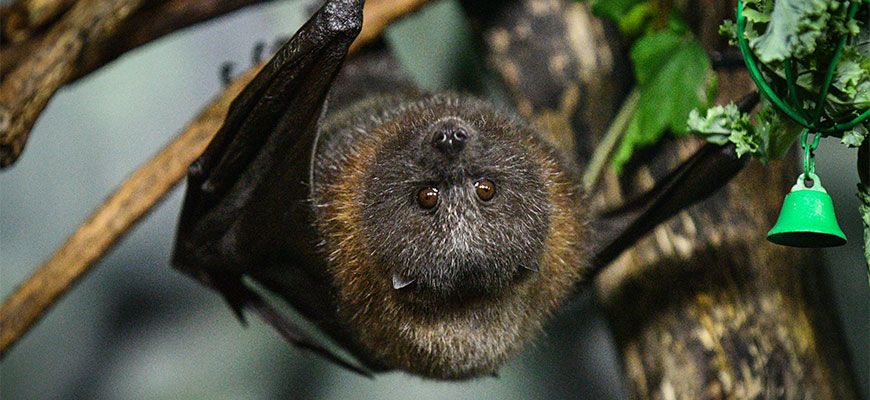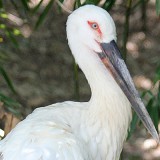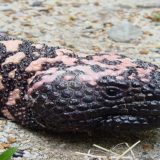CLASSIFICATION:
Order: Chiroptera
Family: Pteropodidae
Genus: Pteropus
Species: rodricensis
RANGE
The remote tropical island of Rodrigues, which with Mauritius and Reunion islands constitutes the Mascarene Islands, located in the Indian Ocean.
HABITAT
Prefer heavily wooded areas of unmanaged forests with large mature trees. Today, on the island of Rodrigues, large stands are generally made up of introduced species such as Mango, Jamrosa, Razuna and Traveller’s palm. The last stands of these types of forest are found in the Cascade Pigeon and Solitaire valleys on the island of Rodrigues.
SIZE
Wingspan: Up to 90 cm (36 inches)
Weight: Males: 350-500 g. (12¼–17½ oz.) Females: 350-450 g. (12¼–15¾ oz.)
REPRODUCTION
Gestation: 140–150 days
Sexual Maturity: 2 years
Rodrigues Fruit Bats breed on an annual cycle. A typical male will attempt to gather a harem of up to about eight females, which forms the basic social structure within the fruit bat colony. Males intensely groom and sniff the females that are being courted, often fanning their wings toward the receptive female in an attempt to clasp her. Both males and females vocalize loudly during mating. Mating may occur several times between each pair of animals. In the wild, birth takes place between the months of October and December. In captivity, especially in the northern hemisphere where seasons are reversed, birthing is generally in the months of April through June. There are few obvious signs of pregnancy in expectant mothers.
Females adopt a horizontal position, with stomach facing upwards and the newborn infant will emerge onto the abdomen. The birth process can take from 5 minutes to 2 hours, with an average of about 65 minutes. The average weight of an infant is 45g (approximately 1/6 the mother’s weight). Babies eyes are open soon after birth and the young are very active. Mothers will carry the young bats with them when feeding. In captivity, young will be left at roosting areas at around the age of 3 weeks while the mothers feed, in the wild mothers will carry infants much longer. At 10 weeks infants will frequently move around on their own and are completely weaned at about 6 months.
DIET
Wild: Flowers, fruits, nectar and ripe seed pods of such species as the tamarind tree, jamosa, mango, various species of vocoa and eucalyptus, palms, fig, benjoin and guango.
Zoo: Variety of fresh fruit and vegetables, flowers, leaves and blossoms when available. Fruit juices. Prefer soft fruits such as banana, melons, grapes and mango. Generally feed on the juices of fruits, discarding the pulp.
BEHAVIOR
Rodrigues Fruit Bats are colonial by nature. They gather in social groups that usually are made-up of one male and several females, known as a harem, or as mixed-sex subadults in groups of around 15. During the day, which is generally an inactive period for the bats, they tend to be solitary, however at night during the active stage they will regroup for social interaction and feeding. Males will stake out feeding and roosting territories. Feeding territories may overlap, but roosting territories are kept completely separate and males will vigilantly defend and maintain the roosting areas. Females within a males roosting territory have been observed aggressively warding off intruders.
POINTS OF INTEREST
The Rodrigues Fruit Bat is one of a number of large bats that are often referred to as “Flying Foxes” due to the size and shapes of the animals head, which are fox-like in appearance. These species of bats depend on their keen sense of smell and eyesight for finding food and do not use echolocation like many of their smaller relatives. Rodrigues Fruit bats are thickly furred, and generally the coat is a chestnut brown except for a mantle of golden brown hair on the neck, head and shoulders. There is a considerable variation in this color pattern among individuals. The thumb has a hooked claw which can be used for climbing and the second finger also contains a claw. The Rodrigues Fruit Bat has no tail.
The main threats to the Rodrigues Fruit Bat is poaching for food and destruction of habitat. With booming human population growth on the small island of Rodrigues, there has been an increase of families engaged in subsistence farming and grazing of introduced livestock. Forested areas are in rapid decline, and with this decrease in roosting and foraging areas the bats numbers have declined. With the decline of forested areas on the island, tropical storms have become a major problem for those fruit bats still living in the wild. At one point in the early 1970s, the Rodrigues Fruit bat was considered the rarest bat in the world, numbering between 70–80 surviving specimens. With captive breeding measures, that were started around 1976, the 2006 figures showed a U.S. captive population of around 250. It is estimated that today the overall Rodriques Fruit Bat population is around 2000.
STATUS
IUCN— Listed as Endangered
CITES— Listed in Appendix II
USDI — Listed as Endangered
REFERENCES
Walker’s Bats of the World, Ronald M. Nowak, 1994
Management and Behavior of the Rodrigues Fruit Bat, Debbie Baker, Zookeeper–Folsom Children’s Zoo, Lincoln, NE.
Rodrigues Fruit Bats: History, Distribution and Status in the Wild, Woodland Park Zoo Education Center
The Encyclopedia of Mammals, Dr. David MacDonald, Editor, 1985
Grzimek’s Animal Life Encyclopedia, Dr. Dr. h.c. Bernhard Grzimek, Editor-in-chief, 1975







